Статьи журнала - International Journal of Image, Graphics and Signal Processing
Все статьи: 1056
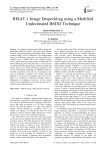
RISAT-1 Image Despeckling using a Modified Undecimated BM3D Technique
Статья научная
In synthetic aperture radar (SAR) imaging, the transmitted microwave pulses from space born antenna interacts with ground objects and returned energy or back scattered energy will be collected to get backscattered image. In SAR image processing, a not anticipated noise (speckle noise) is added due to the coherent imaging system, which makes the image analysis troublesome. For better SAR image processing, the noise is to be removed or minimized in the begging stages of pre-processing and texture features are to be effectively maintained. The wavelet based Block Matching 3D (BM3D) method is normally considered as the state of art technique in the area of denoising of images. This method generally depends on up and down sampling conversion. In this paper, it is proposed a denoising technique which is independent on sampling conversion, so that texture features can be maintained, in which the speckle noise is reduced to the maximum extent.
Бесплатно
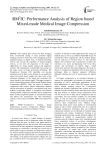
RM2IC: Performance Analysis of Region based Mixed-mode Medical Image Compression
Статья научная
The medical data science has been changing from conventional analog to more powerful digital imaging systems for some time. These imagining systems produced images in digital form. As digital technology evolves and exceeds the capability of analog imaging devices, so too does the expansion in the range of applications for image guided surgical and diagnostic systems. The optimization of bandwidth and storage are the major issues in image processing technology. The Compressive Sensing (CS) algorithm can become prominent tool for these issues because it can sample the signal with much lesser sample rate than twice of the maximum frequency of the signal and reconstruct the signal similar to the original signal. This paper, presents a novel scheme Region based Mixed-mode Medical Image Compression (RM2IC). Here, the region of interest is compressed with lossless hybrid compression methods and the non-region of interest is com-pressed with lossy hybrid CS algorithm. RM2IC is compared with different existing hybrid compression methods and it outperforms better visual perceptional quality of reconstructed image and reduces the compression rate. The performance analysis is done based on PSNR, MSE and compression ratio.
Бесплатно
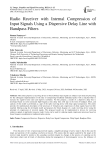
Статья научная
This article proposes a receiving device in which arbitrary input signals are subject to pre-detector processing for the subsequent implementation of the idea of compressing broadband modulated pulses with a matched filter to increase the signal-to-noise ratio and improve resolution. For this purpose, a model of a dispersive delay line is developed based on series-connected high-frequency time delay lines with taps in the form of bandpass filters, and analysis of this model is performed as a part of the radio receiving device with chirp signal compression. The article presents the mathematical description of the processes of formation and compression of chirp signals based on their matched filtering using the developed model and proposes the block diagram of a radio receiving device using the principle of compression of received signals. The proposed model can be implemented in devices for receiving unknown signals, in particular in passive radar. It also can be used for studying signal compression processes based on linear frequency modulation in traditional radar systems.
Бесплатно
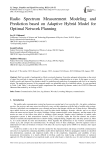
Статья научная
Path loss model is fundamental to effective network planning. It provides adequate information on the extent of signal loss and help to improve the quality of service of cellular communication in an area. In this paper we used a hybrid wavelet and improved log-distance model for modeling and prediction of propagation path loss in an irregular terrain. The prediction accuracy of the proposed model was quantified using five statistical metrics. As seen presented in Table 2 and Table 3, the proposed model outperformed the standard log-distance model, the COST234 Hata and Okumura Hata models by an average of 20%.
Бесплатно
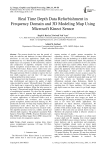
Статья научная
The present decade has seen the growth of both, the software and hardware for three dimensional televisions in real time applications. Depth map is fundamental key of 3-Dimensional algorithms. Reliable depth map is an acceptance in 3D transmission, analysis and compression of algorithm. Computer vision and pattern recognition research fields use sensor like low cost Microsoft kinect. Kinect sensor suffers from some problems of noise, poor accuracy and unmatched edges. This paper presents effective solution to improve the real time depth sequences and real time 3-D map using warping method from kinect sensor. We proposed real time frequency domain based depth data refurbishment and improve the quality of depth video provided by sensors' Microsoft Kinect. The quality of the depth map is improved by depth refurbishment in frequency domain technique, filling the holes present in the maps, 2-Dimensional spatial filtering and permutation of morphological operation. We show that the proposed approach is able to generate high quality depth maps which can be quite useful in improving the performance of various applications of Microsoft Kinect such as obstacle detection and avoidance, pose estimation, gesture recognition, skeletal and facial tracking, etc. We produce the real time 3-D map using warping method. An experimental result shows that the quality of our proposed method is better than previous research works. Our algorithm produces noise less, reliable, smooth and efficient depth sequence. The qualitative parameter Peak Signal to Noise Ratio (PSNR), Structure Similarity Index Map (SSIM) and Mean Square Error (MSE) measure the real time results for comparative analysis.
Бесплатно
Real Time Detection and Tracking of Human Face using Skin Color Segmentation and Region Properties
Статья научная
Real time faces detection and face tracking is one of the challenging problems in application like computer human interaction, video surveillance, biometrics etc. In this paper we are presenting an algorithm for real time face detection and tracking using skin color segmentation and region properties. First segmentation of skin regions from an image is done by using different color models. Skin regions are separated from the image by using thresholding. Then to decide whether these regions contain human face or not we used face features. Our procedure is based on skin color segmentation and human face features (knowledge-based approach). We have used RGB, YCbCr, and HSV color models for skin color segmentation. These color models with thresholds, help to remove non skin like pixel from an image. Each segmented skin regions are tested to know whether region is human face or not, by using human face features based on knowledge of geometrical properties of human face.
Бесплатно
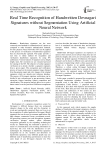
Статья научная
Handwritten signatures are the most commonly used method for authentication of a person as compared to other biometric authentication methods. For this purpose Neural Networks (NN) can be applied in the process of verification of handwritten signatures that are electronically captured. This paper presents a real time or online method for recognition and verification handwritten signatures by using NN architecture. Various features of signature such as height, length, slant, Hu's moments etc are extracted and used for training of the NN. The objective of online signature verification is to decide, whether a signature originates from a given signer. This recognition and verification process is based on the instant signature image obtained from the genuine signer and a few images of the original signatures which are already part reference database. The process of Devnagari signature verification can be divided it into sub-processes as pre-processing, feature extraction, feature matching, feature comparison and classification. This stepwise analysis allows us to gain a better control over the precision of different components
Бесплатно
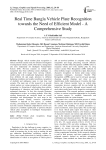
Статья научная
Bangla vehicle number plate recognition is still an unsolved research issue for efficient investigation of unregistered vehicles, traffic observation, management and most importantly for Intelligent Transportation System (ITS). Previous research on vehicle plate recognition have been suffering various challenges, i.e. capturing high level image from moving vehicles, number plate with complicated background, detection from different tilt and angle, detection in different lightening conditions and weather conditions, recognition of doubtful and ambiguous signs in road time road scenario. The main aim of this research is to provide critical analysis on various perspectives of vehicle plate recognition, i.e. Extraction of vehicle plates from vehicle, Segmentation of characters and finally, Recognition of segmented characters. At first, this research illustrates comprehensive reviews on existing methods. After that, existing frameworks are analyzed based on overall advantages and disadvantages for each steps in the previous research. Finally, extensive experimental validation is depicted in five aspects, i.e. method, accuracy, processing time, datasets and relevancy with real time scenario. Proposed comprehensive reviews are expected to contribute significantly to perform efficient vehicle plate recognition in Intelligent Transportation System (ITS) research.
Бесплатно
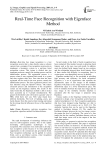
Real-Time Face Recognition with Eigenface Method
Статья научная
Real-time face image recognition is a face recognition system that is done directly using a webcam camera from a computer. Face recognition system aims to implement a biometrics system as a real-time facial recognition system. This system is divided into two important processes, namely the training process and the identification process. The registration process is a process where a user registered their name in a system and then registers their face. Face data that has been registered will be used for the next process, namely the identification process. The face registration process uses face detection using the OpenCV library. The feature extraction process and introduction to the recognition system use the Eigenface method. The results of this study found that, the Eigenface method is able to detect faces accurately up to 4 people simultaneously. The greater the threshold value will result in a greater value of FRR, while there isn’t any FAR value found from different thresholds. The level of lighting, poses, and facial distance from the camera when training and testing the face image heavily influences the use of the eigenface method.
Бесплатно
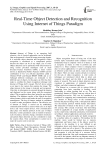
Real-Time Object Detection and Recognition Using Internet of Things Paradigm
Статья научная
Internet of Things is an emerging field wherein a lot of classical approaches can be inculcated. One such approach is found in image processing domain. It is real-time object detection and recognition. Object recognition is considered as a complicated process because the object can be of any shape, size or color. Object detection can be performed with effectiveness by using various prevalent techniques such as Scale Invariant Feature Transform (SIFT), a faster version known as Speeded-Up Robust Features (SURF) and the combination of two very efficient algorithms called as Oriented FAST and Rotated BRIEF (ORB) and so on. Although different techniques are dedicated to the different type of objects. In this paper, an effort has been made to combine the object recognition technique with Internet of Things (IoT) concept. The IoT device acting as an input is the camera that captures the image. The object present in the image is detected and recognized. After that, its information is extracted through the internet and displayed on the screen along with the recognized object. The recognition takes place using the pre-existing database. The database consists of the objects that have salient features which would make the task of recognition unambiguous. The bag of features method is considered in order to make recognition effective. The effective use of Internet of Things is carried out by establishing communication between a camera which acts as an input device and visual output devices. This communication takes place over Internet protocol. In the case of object detection, various parameters such as rotation invariance, scale invariance, intensity change, orientation invariance and partial object detection are also considered to make the system robust. Time consideration is carried out to make the system work in real time.
Бесплатно
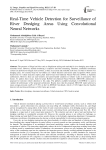
Статья научная
The presence of illegal activities such as illegitimate mining and sand theft in river dredging areas leads to economic losses. However, manual monitoring is expensive and time-consuming. Therefore, automated surveillance systems are preferred to mitigate such activities, as they are accurate and available at all times. In order to monitor river dredging areas, two essential steps for surveillance are vehicle detection and license plate recognition. Most current frameworks for vehicle detection employ plain feed-forward Convolutional Neural Networks (CNNs) as backbone architectures. However, these are scale-sensitive and cannot handle variations in vehicles' scales in consecutive video frames. To address these issues, Scale Invariant Hybrid Convolutional Neural Network (SIH-CNN) architecture is proposed for real-time vehicle detection in this study. The publicly available benchmark UA-DETRAC is used to validate the performance of the proposed architecture. Results show that the proposed SIH-CNN model achieved a mean average precision (mAP) of 77.76% on the UA-DETRAC benchmark, which is 3.94% higher than the baseline detector with real-time performance of 48.4 frames per seconds.
Бесплатно
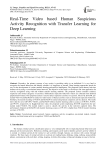
Real-Time Video based Human Suspicious Activity Recognition with Transfer Learning for Deep Learning
Статья научная
Nowadays, the primary concern of any society is providing safety to an individual. It is very hard to recognize the human behaviour and identify whether it is suspicious or normal. Deep learning approaches paved the way for the development of various machine learning and artificial intelligence. The proposed system detects real-time human activity using a convolutional neural network. The objective of the study is to develop a real-time application for Activity recognition using with and without transfer learning methods. The proposed system considers criminal, suspicious and normal categories of activities. Differentiate suspicious behaviour videos are collected from different peoples(men/women). This proposed system is used to detect suspicious activities of a person. The novel 2D-CNN, pre-trained VGG-16 and ResNet50 is trained on video frames of human activities such as normal and suspicious behaviour. Similarly, the transfer learning in VGG16 and ResNet50 is trained using human suspicious activity datasets. The results show that the novel 2D-CNN, VGG16, and ResNet50 without transfer learning achieve accuracy of 98.96%, 97.84%, and 99.03%, respectively. In Kaggle/real-time video, the proposed system employing 2D-CNN outperforms the pre-trained model VGG16. The trained model is used to classify the activity in the real-time captured video. The performance obtained on ResNet50 with transfer learning accuracy of 99.18% is higher than VGG16 transfer learning accuracy of 98.36%.
Бесплатно
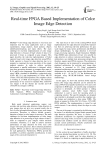
Real-time FPGA Based Implementation of Color Image Edge Detection
Статья научная
Color Image edge detection is very basic and important step for many applications such as image segmentation, image analysis, facial analysis, objects identifications/tracking and many others. The main challenge for real-time implementation of color image edge detection is because of high volume of data to be processed (3 times as compared to gray images). This paper describes the real-time implementation of Sobel operator based color image edge detection using FPGA. Sobel operator is chosen for edge detection due to its property to counteract the noise sensitivity of the simple gradient operator. In order to achieve real-time performance, a parallel architecture is designed, which uses three processing elements to compute edge maps of R, G, and B color components. The architecture is coded using VHDL, simulated in ModelSim, synthesized using Xilinx ISE 10.1 and implemented on Xilinx ML510 (Virtex-5 FX130T) FPGA platform. The complete system is working at 27 MHz clock frequency. The measured performance of our system for standard PAL (720x576) size images is 50 fps (frames per second) and CIF (352x288) size images is 200 fps.
Бесплатно
Real-time Object Tracking with Active PTZ Camera using Hardware Acceleration Approach
Статья научная
This paper presents the design and implementation of a dedicated hardware (VLSI) architecture for real-time object tracking. In order to realize the complete system, the designed VLSI architecture has been integrated with different input/output video interfaces. These video interfaces along with the designed object tracking VLSI architecture have been coded using VHDL, simulated using ModelSim, and synthesized using Xilinx ISE tool chain. A working prototype of complete object tracking system has been implemented on Xilinx ML510 (Virtex-5 FX130T) FPGA board. The implemented system is capable of tracking the moving target object in real-time in PAL (720x576) resolution live video stream directly coming from the camera. Additionally, the implemented system also provides the real-time desired camera movement to follow the tracked object over a larger area.
Бесплатно
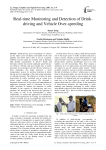
Real-time monitoring and detection of drink-driving and vehicle over-speeding
Статья научная
Drink-driving and over-speeding of vehicles are the major causes of injuries and deaths on the road globally and South Africa (SA) is not an exception. Different systems which are currently used in detecting high alcohol concentration in drivers’ breath and detecting vehicles that exceeds stipulated speed limit are not effective, efficient and poses health risks to traffic personnel. In an attempt to provide effective solutions to these challenges, this paper proposed a smart transportation system for real-time detection of drink-driving and over-speeding on the roads using technology of vehicular networks. The objective is to allow for early intervention by traffic personnel aim at saving lives before actual accident occurred. We designed a theoretical framework of the system and implemented an application prototype which is web-based for use by traffic personnel to monitor the detection of traffic offenders in the capacity of drink-driving and over-speeding. We presented and discussed the operation of the system as well as the functionalities it offers. Additionally, we utilized the application to simulate the actual system and based on its working, we found that the system is feasible and can accomplish the tasks of road safety more effective than the existing approaches.
Бесплатно
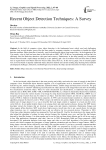
Recent Object Detection Techniques: A Survey
Статья научная
In the field of computer vision, object detection is the fundamental most widely used and challenging problem. Last several decades, great effort has been made by computer scientists or researchers to handle the object detection problem. Object detection is basically, used for detecting the object from image/video. At the beginning of the 21st century, a lot of work has been done in this field such as HOG, SIFT, SURF etc. are performing well but can’t be efficiently used for Real-time detection with speed and accuracy. Furthermore, in the deep learning era Convolution Neural Network made a rapid change and leads to a new pathway and a lot of excellent work has been done till dated such as region-based convolution network YOLO, SSD, retina NET etc. In this survey paper, lots of research papers were reviewed based on popular traditional object detection methods and current trending deep learning-based methods and displayed challenges, limitations, methodologies used to detect the object and also directions for future research.
Бесплатно
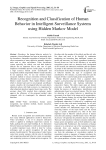
Статья научная
Nowadays, the human behavior analysis by computer vision techniques has been an interesting issue for researchers. Automatic recognition of actions in video allows automation of many otherwise manually intensive tasks such as video surveillance. Video surveillance system especially for elderly care and their behavior analysis has an important role to take care of aged, impatient or bedridden persons. In this paper, we propose a high accuracy human action classification and recognition method using hidden Markov model classifier. In our approach, first, we use star skeleton feature extraction method to extract extremities of human body silhouette to produce feature vectors as inputs of hidden Markov model classifier. Then, hidden Markov model, which is learned and used in our proposed surveillance system, classifies the investigated behaviors and detects abnormal actions with high accuracy in comparison by other abnormal detection reported in previous works. The accuracy about 94% resulted from confusion matrix approve the efficiency of the proposed method when compared with its counterparts for abnormal action detection.
Бесплатно
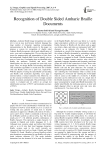
Recognition of Double Sided Amharic Braille Documents
Статья научная
Amharic Braille image recognition into a print text is not an easy task because Amharic language has large number of characters requiring corresponding representations in the Braille system. In this paper, we propose a system for recognition of double sided Amharic Braille documents which needs identification of recto, verso and overlapping dots. We used direction field tensor for preprocessing and segmentation of dots from the background. Gradient field is used to identify a dot as recto or verso dots. Overlapping dots are identified using Braille dot attributes (centroid and area). After identification, the dots are grouped into recto and verso pages. Then, we design Braille cell encoding and Braille code translation algorithms to encode dots into a Braille code and Braille codes into a print text, respectively. With the purpose of using the same Braille cell encoding and Braille code translation algorithm, recto page is mirrored about a vertical symmetric line. Moreover, we use the concept of reflection to reverse wrongly scanned Braille documents automatically. The performance of the system is evaluated and we achieve an average dot identification accuracy of 99.3% and translation accuracy of 95.6%.
Бесплатно
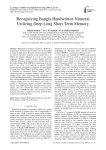
Recognizing Bangla handwritten numeral utilizing deep long short term memory
Статья научная
Handwritten numeral recognition (HNR) has gained much attention in present days as it can be applied in range of applications. Research on unconstrained HNR has shown impressive progress in few scripts but is far behind for Bangla although it is one of the major languages. Bangla contains similar shaped numerals which are difficult to distinguish even in printed form and this makes Bangla HNR (BHNR) a challenging task. Our goal in this study is to build up a superior BHNR framework and consequently explore the profound design of Long Short Term Memory (LSTM) method. LSTM is a variation of Recurrent Neural Network and is effectively used for sequence ordering with its distinct features. This study considered deep architecture of LSTM for better performance. The proposed BHNR with deep LSTM (BNHR-DLSTM) standardizes the composed numeral images first and then utilizes two layers of LSTM to characterize singular numerals. Benchmark dataset with 22000 handwritten numerals having various shapes, sizes and varieties are utilized to examine the proficiency of BNHR-DLSTM. The proposed method indicates agreeable recognition precision and beat other conspicuous existing methods.
Бесплатно
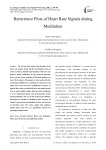
Recurrence Plots of Heart Rate Signals during Meditation
Статья научная
The current study analyses the dynamics of the heart rate signals during specific psychological states in order to obtain a detailed understanding of the heart rate patterns during meditation. In the proposed approach, heart rate time series available in Physionet database are used. The dynamics of the signals are then analyzed before and during meditation by examining the attractors in the phase space and recurrence quantification analysis. In general, the results reveal that the heart rate signals transit from a chaotic, highly-complex behavior before meditation to a low dimensional chaotic (and quasi-periodic) motion during meditation. This can be due to decreased nonlinear interaction of variables in meditation states and may be related to increased parasympathetic activity and increase of relaxation state. The results suggest that nonlinear chaotic indices may serve as a quantitative measure for psychophysiological states.
Бесплатно

